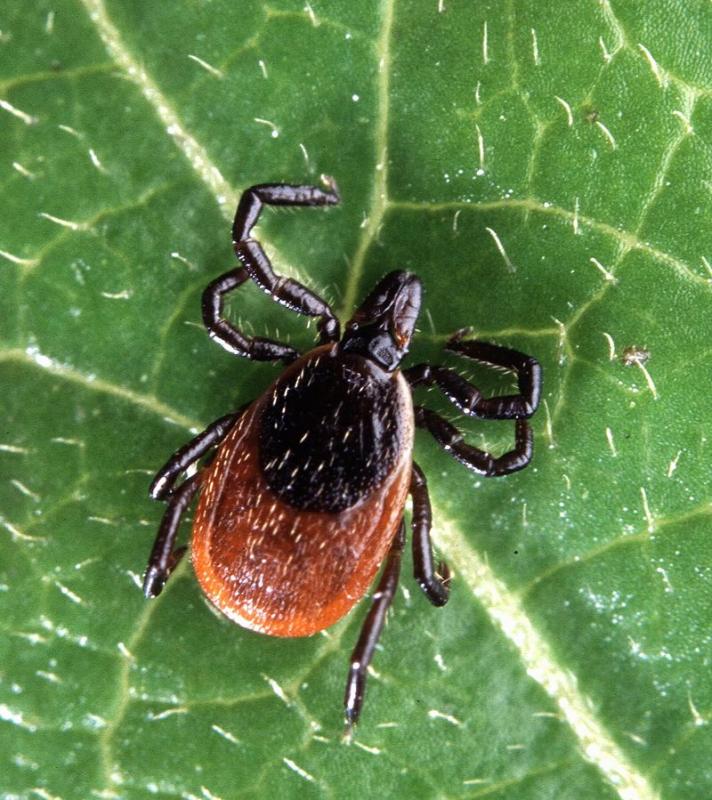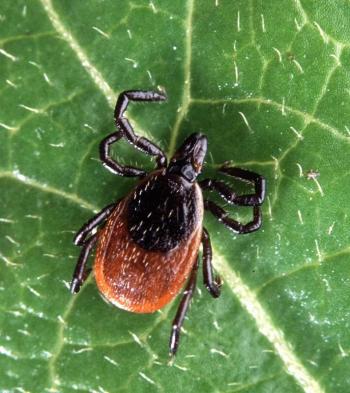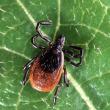Despite dry conditions, Lincoln County and Midcoast see high rates of tickborne disease
 Deer ticks, or blacklegged ticks transmit several serious diseases, including Lyme disease, anaplasmosis, babesiosis and Powassan disease. Pictured is an adult female, which is roughly the size of a sesame seed. In the spring, nymph deer ticks are roughly the size of a poppy seed. For more information: http://www.cdc.gov/ticks/. Courtesy photo
Deer ticks, or blacklegged ticks transmit several serious diseases, including Lyme disease, anaplasmosis, babesiosis and Powassan disease. Pictured is an adult female, which is roughly the size of a sesame seed. In the spring, nymph deer ticks are roughly the size of a poppy seed. For more information: http://www.cdc.gov/ticks/. Courtesy photo
 Deer ticks, or blacklegged ticks transmit several serious diseases, including Lyme disease, anaplasmosis, babesiosis and Powassan disease. Pictured is an adult female, which is roughly the size of a sesame seed. In the spring, nymph deer ticks are roughly the size of a poppy seed. For more information: http://www.cdc.gov/ticks/. Courtesy photo
Deer ticks, or blacklegged ticks transmit several serious diseases, including Lyme disease, anaplasmosis, babesiosis and Powassan disease. Pictured is an adult female, which is roughly the size of a sesame seed. In the spring, nymph deer ticks are roughly the size of a poppy seed. For more information: http://www.cdc.gov/ticks/. Courtesy photo
Dry conditions have kept tick populations subdued over much of the state but the midcoast, including Lincoln County, continues to see high rates of Lyme disease and record levels of anaplasmosis, according to the Maine Centers for Disease Control and Prevention (CDC).
Lincoln County had 32 cases of Lyme through Aug. 18, or 94 cases per 100,000 people, according to the Maine CDC, the highest rate of any county in Maine. Over that same period, the county saw a record 46 cases of anaplasmosis, a relatively new tickborne disease that can cause severe flu-like symptoms.
For residents of coastal counties like Lincoln and Knox, the bottom line is that while dry weather has kept the tick population under stress in most of the state, Lyme and other tickborne illnesses remain a threat, especially in areas along the immediate coast that have escaped the worst of the drought.
Charles Lubelczyk, a Vector Ecologist at the Maine Medical Center Research Institute, said very few ticks were found in some inland areas - some of which were experiencing the driest conditions- during summer tick surveys. Closer to the coast the tick population has been much higher.
Because more ticks mean more tick borne disease, the highest levels of Lyme and other tick borne diseases are in the coastal counties of Knox, Waldo and Hancock, according to Maine CDC statistics.
As of Aug. 18, 424 cases of Lyme disease had been reported statewide, according to the Maine CDC. All numbers reported by the Maine CDC are preliminary. Because there is a lag between infection and when the disease is actually reported, numbers will rise significantly by the end of the year.
The incidence of Lyme disease has climbed dramatically over the past 10 years in Maine, hitting a record of 1408 cases in 2014. According to national statistics, Maine also had the highest rate of Lyme disease nationwide that year, the last year for which national statistics are available.
In addition to Lyme disease, anaplasmosis and babesiosis, two potentially serious tickborne diseases that are also spread by the deer tick, or black-legged tick, have increased dramatically in Maine.
As of Aug. 18, the state has already seen 56 cases of babesiosis and 225 cases of anaplasmosis, more than the state has seen in any previous year. For all of 2015, there were 191 cases of anaplasmosis and 55 cases of babesiosis in Maine.
Symptoms of babesiosis include extreme fatigue, aches, chills, sweating and dark urine. Anaplasmosis symptoms include fever, headaches, malaise, nausea and body aches. Both illnesses can be severe and even life threatening, especially for elderly people or people with compromised immune systems.
Lyme disease is usually diagnosed through the presence of a target, or bulls-eye rash more than two inches in diameter. Other symptoms of Lyme disease include flu-like symptoms, a stiff neck, chills, fever, swollen lymph nodes, headaches, and joint pain.
Lubelczyk said it was not clear why anaplasmosis and babesiosis have increased so dramatically, but he said it could be the result of relatively high populations of the small mammals that the ticks use as hosts. He said it is also possible that more people are being diagnosed because providers are becoming more familiar with the diseases.
One tick borne illness that has not appeared in Maine so far is Powassan disease, caused by a virus that can result in inflammation of the brain, causing long lasting neurological symptoms or death. But most people who are infected will experience few, if any, symptoms.
One reason the Powassan virus is a greater concern to physicians and biologists, is that it can be transmitted much more quickly – sometimes in less than an hour. A tick has to be attached for at least 24 hours before Lyme and other tick-borne diseases are transmitted. Another reason for concern is that there is no treatment for the virus.
While Powassan is fairly rare in humans, the virus is found ticks in many parts of the state. Lubelczyk is currently doing a survey of ticks to better understand where the virus is present in the state.
Precautions against tickborne diseases (Source U.S. Centers for Disease Control):
- Ticks live in moist or humid environments in woody or grassy areas. When hiking, walk in the center of trails, and when possible and wear long pants and sleeves.
- Permethrin kills ticks. Use it on clothes, boots and camping gear. Use a repellent with DEET on skin.
- After you come in from outdoors, check your skin and clothing for ticks and remove any them. Washing clothes may not kill ticks, but your dryer’s high heat cycle will.
- Shower soon after coming indoors and check skin everywhere for ticks.
- For more information: http://www.cdc.gov/features/stopticks/.
Event Date
Address
United States






















